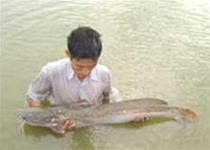'Revive' rare species of fish
Scientists at the Research Institute for Aquaculture No. 1 (Ministry of Fisheries) have successfully implemented artificial reproduction of spotted fish (rare but highly endangered fish species) in culture conditions.
 (Photo: TTO) According to the project leader Nguyen Duc Tuan (Research Institute for Aquaculture No. 1), due to the impact of degraded environmental conditions such as deforestation, damming, gold training in the riverbed, in particular, the impact of large hydroelectric dams blocking rivers causing loss of spawning grounds, and over-exploitation by destructive means such as electric impulses, explosives, poison and fish and other means of exploitation, the production of pangasius has declined significantly.
(Photo: TTO) According to the project leader Nguyen Duc Tuan (Research Institute for Aquaculture No. 1), due to the impact of degraded environmental conditions such as deforestation, damming, gold training in the riverbed, in particular, the impact of large hydroelectric dams blocking rivers causing loss of spawning grounds, and over-exploitation by destructive means such as electric impulses, explosives, poison and fish and other means of exploitation, the production of pangasius has declined significantly.
The first job, according to Tuan, is to buy broodstock from Lo Gam river (Tuyen Quang), Hoa Binh hydropower reservoir to keep in a static water pond at the Research Institute for Aquaculture 1. Research results From 2002 to present, this fish has been adapted relatively well to the pond culture environment, they grow fast, the average growth rate reaches 58-142gr / month.
Lentils can grow in the environment of static water ponds, but require clean water environment, avoid farming in stagnant ponds and lakes. It should be raised in areas where water supply is active, especially where there is frequent water flowing into the pond. It is possible to use industrial pellets with high protein and lipid content to feed on catfish. Used in conjunction with trash fish. When raising lemongrass, it is recommended to raise single fishes, so it is better to add more sesame fish to clean the water.
Currently, the Research Institute for Aquaculture No. 1 is carrying out the research project on technology for growing chimpanzee fish with the implementation period from January 2005 to December 2007.
In 2004, with the application of broodstock techniques with live feed, prolonging the pumping time to create flow and artificial rain in ponds has obtained very encouraging results. The rate of mature broodstock and spawning rate is over 90%, the average fertilization rate is 76%, the average hatching rate is 58%, this result is significantly higher than in 2002 and 2003; has arranged experiments to rear fry, fry and fingerlings and find out suitable stocking density. In 2003, 7,800 fry and 5,000 fingerlings were collected. In 2004, 194,000 fry were collected, over 12,000 fry and fingerlings.
The project also tested commercial fish farming with fresh food, processed food with crude protein content ranging from 35-40-45%. The results show that the growth rate of fish increases gradually when feeding food has the highest and higher protein content when feeding live food.
Talking about reproductive techniques, Mr. Tuan said the spotted fish is a relatively large species, predatory (being carnivorous), low reproductive power, thus reducing the risk of natural resources leading to extinction. is easy to happen. The type of fish selected for artificial reproduction is male fish weighing more than 3 kg (4 years and older), females over 2 kg (3 years and older).

(Photo: TTO)
In particular, the most difficult is the gonads of the piece of snakehead fish, without clawing, so the male fish must be operated to get the gland to fertilize the egg, then sterilize and stitch it to continue feeding but still ensure the rate live of females after reproductive about 80%, males about 70-80%. Artificial breeding fish for good quality.
The implementation of artificial reproduction of lenticular fish is still facing some difficulties. According to Mr. Tuan, this technology is new, quite complicated, quite different from other traditional objects such as bighead carp, drifting, carp, copying from broodstock breeding techniques, artificial reproduction, hatching eggs. , nursing fry . and requires a skilled technician.
'Low fish fertility, late maturity is also a challenge to quickly develop this species. Besides, in order to apply new technology, it is required to have a skilled technical staff on artificial reproduction, good infrastructure, and a clean water supply system, ' Tuan said.
- Protecting rare and precious fish species in flipping Binh Thien
- Detecting exotic rare fish in Nam Dinh
- Top 10 rare and expensive fishes in Vietnam
- Discover new, extremely rare fish
- Discovered a lot of particularly hardy toad fish in Phu Tho
- Artificial reproduction of four rare and precious fish species
- Looking at species of sea fish,
- Journey to find rare species of bitter fish in Hoang Lien Son range
- Artificial reproduction of the spotted fish, spotted fish
- Preservation and successful development of rare and precious species of catfish
- Discovering fish with legs in Cao Bang
- Sea fishing 'armored' rare and precious fishermen
 Animal 'suffering' after hibernation
Animal 'suffering' after hibernation Why do goats climb well?
Why do goats climb well? Scientists were surprised to see chimpanzees eating turtles
Scientists were surprised to see chimpanzees eating turtles Giant catfish died deadly due to drought in Thailand
Giant catfish died deadly due to drought in Thailand